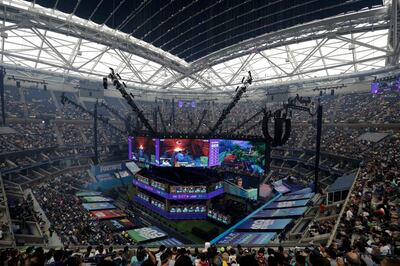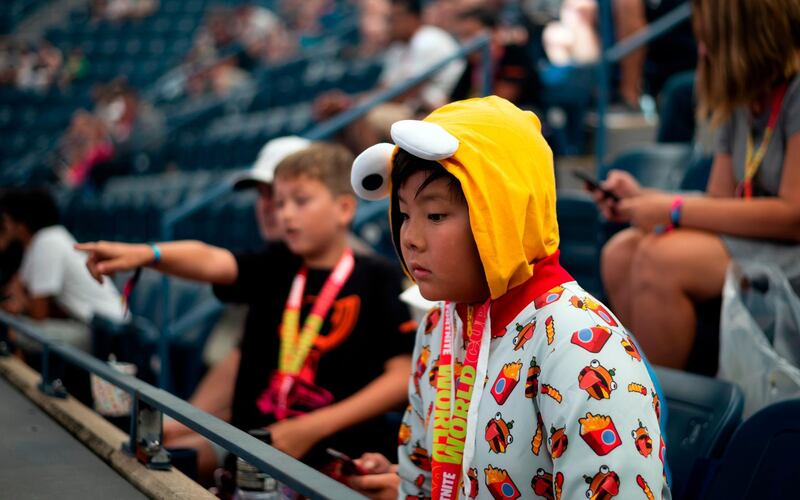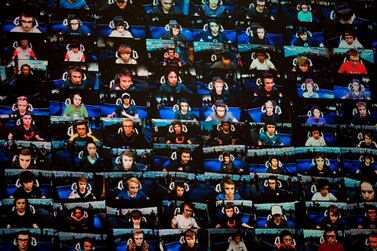If you weren't aware that the spectacle of teenagers wielding video game controllers had become a global spectator sport, last month's Fortnite World Cup provided irrefutable proof. The competition, held at the Arthur Ashe Stadium in New York, culminated in a roaring crowd, silverware, ticker tape and a mammoth first prize of $3 million (Dh11m). This went to American player Kyle Giersdorf, 16, also known as Bugha, with another $4m distributed between the three runners up.
As news of the win flashed across the world, competitive gaming, known as esports, became more than simply the geeky younger brother of traditional sport. It now commands audiences, news coverage, sponsorship and prize money comparable with well-established competitions. By winning the Fortnite World Cup, Giersdorf scooped more than Tiger Woods did for his Masters triumph in April, when the golfer earned $2m.
So, what's behind the exponential rise in esports?
Investment firm Goldman Sachs says the success of survivalist video gameFortnite has been largely responsible for this cultural shift, but the popularity of esports has been growing under the mainstream's radar for years. Millions of people compete from their homes in games such as PlayerUnknown's Battlegrounds, League of Legends and Dota 2, and millions more watch games streamed live on platforms such as Twitch, YouTube and Mixer. For them, watching competitive sport unfolding in computer-generated environments is as compelling, if not more so, than watching 22 people kick a ball around a football pitch.
The Cristiano Ronaldo or Lionel Messi of esports might be Germany's Kuro Takhasomi (KuroKy) or Pakistan's Sumail Hassan (SumaiL), while its Barcelona or Real Madrid might be teams such as Cloud 9, Team Liquid or NRG. But battles don't only take place across the internet. Last year, 5,000 people packed into Dubai's Festival Arena to watch PUBG players compete for a $600,000 grand prize, and the first esports stadium is under construction in Philadelphia.
Revenue is due to top $1 billion this year
By its nature, esports generates a wealth of numbers that help to illustrate its popularity. According to industry calculations, revenue is due to top $1bn this year, and its global audience will rise to more than half a billion. But Giersdorf's achievement at the Fortnite World Cup was the first time many people heard of esports.
"Competitive video gaming has been around for decades, but it has never been cool," says Paul Dawalibi, venture capitalist and presenter of a podcast entitled The Business of Esports. "The stereotype was the gamer in his basement, playing all night, alone. Whether that was correct or not, the idea was pervasive, so it never made the mainstream. Technology-based hobbies are now more broadly accepted, but it still takes big prize money to prompt my mum to call me and say, 'hey, did you see this?'"
Many people think of video games in the abstract, but the money it generates is real. Hundreds of millions of dollars are spent on the development of games, and consumers spend hundreds of millions more playing them. Fortnite is free to play initially, but its developers, Epic Games, bank more than $200m per month from in-game purchases. Fans will also pay to watch them being played, and games publishers receive huge sums for the media rights, with Twitch paying $90m for the league rights to Overwatch for a two-year period, while Disney, Facebook and YouTube have also written cheques.
'Traditional sports would kill for this kind of audience'
Esports’ growing visibility fuels spending from sponsors and advertisers, particularly in league competitions. “Typically, team owners will buy a spot in a league for anywhere from $10m to $30m,” says Dawalibi. “Then they spend more money to build these teams [with salaried players]. But almost all of their revenue comes from two sources: events and sponsorship.”
Brands have long wondered how to reach the young people who shun traditional media channels, and esports gives them that access. "Traditional sports would kill for this kind of audience," says Dawalibi.
Cloud 9's current list of sponsors include Red Bull, AT&T and even the US Air Force, and with teams also receiving endorsements from high-profile celebrities such as Michael Jordan, valuations have rocketed. (Nine of the top 10 esports teams are all currently worth at least $100m, according to Forbes.)

These huge sums have led to questions about the business's short-term viability. Are high-salary gamers simply burning through investor capital? Is the whole industry built on speculative investment? Is this a bubble waiting to burst? "If you're a publisher such as Activision or Blizzard, you're making a lot of money," says Dawalibi. "But the valuations of the teams are crazy, and in the short term there will be a correction to shake out some of the dumb money that's only there because of the hype."
'We’re not talking billions of dollars, we’re talking trillions of dollars'
That hype may include some of the stats so beloved of the esports industry. In an article for gaming website Kotaku, reporter Cecilia D'Anastasio says the comparisons being made between the estimated viewership of, say, the League of Legends Championship Series (200 million in China alone) and the 2018 Super Bowl (103 million worldwide) is based on unverifiable figures, and they're being wrongly compared in any case, with metrics for traditional sport viewership much more rigorous than hit counts for esports videos.

But even if esports isn't as big as it pretends to be, that doesn't mean it's small. The International, an annual Dota 2 tournament, will this month kick off in Shanghai with a prize pool of more than $30m, $29m of which has come from in-game purchases by fans. "There may be a short-term bubble, but long term everyone is underestimating how big the industry is going to be," says Dawalibi. "We're not talking billions of dollars, we're talking trillions of dollars."
This, he says, is driven by the appeal of esports as a great equaliser. Its stars, such as Giersdorf, are normal kids. And a typical fan's favourite game doesn't only represent entertainment; it's their skill set, their social network, their hangout, and the fact the mainstream has only now realised this is telling. Giesdorf's $3m win almost represented a moment when the adult world woke up and noticed the younger generation.











